From random chaotic vibrations to useful motion—toward new energy-harvesting technologies
Researchers, including Miku Hatatani, a Ph.D. student in the Department of Chemical Engineering and Materials Science, have developed the world’s first symmetric ratchet motor in which a perfectly circular disk spins in one direction when placed on vibrating particles, inspired by molecular motors in biological systems. While conventional rachets rely on asymmetry, this motor emerges from spontaneous symmetry breaking. This discovery highlights a new principle in physics of extracting order from noise, setting the stage for innovative energy-harvesting devices that work on ambient vibrations.
Reference
Hatatani, M., Oguni,J., Yamamoto, D., & Shioi, A., Emergence of a ratchet motor by spontaneous symmetry breaking, Chaos 35,(8), 083102 (2025).
https://doi.org/10.1063/5.0271467
https://research.doshisha.ac.jp/news/news-detail-80/
This achievement has also been featured in the “EurekAlert!.”News Release 11-Sep-2025,
https://www.eurekalert.org/news-releases/1097937
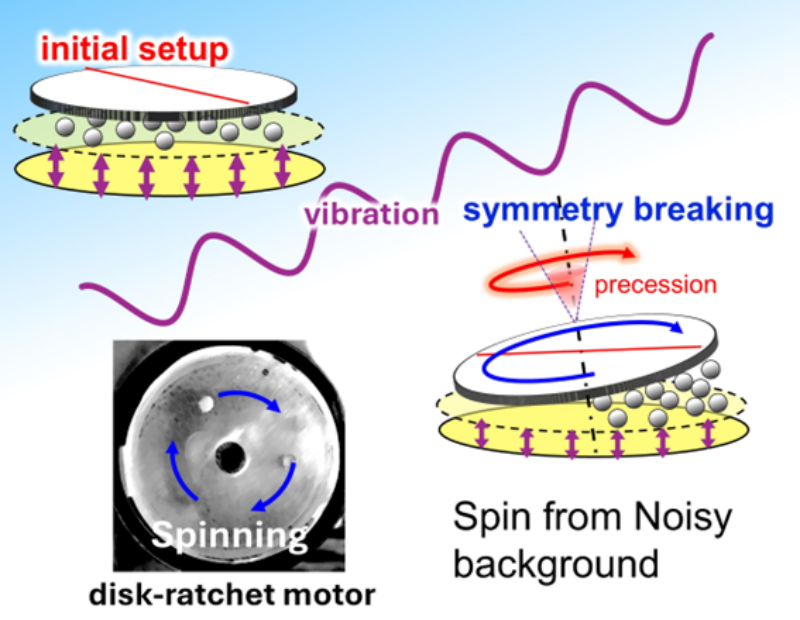
Title: Mechanism of Spontaneous Symmetry Breaking in a Symmetric Ratchet Motor
Caption: In the initial setup, the particles are evenly distributed. But when the disc is placed on the particle bed and subjected to vibration, it spontaneously begins to spin in one direction, demonstrating self-organization arising from breaking of symmetry.
Image credit: Ms. Miku Hatatani from Doshisha University, Japan
Image license: Original content
Usage restrictions: Cannot be used without permission.
| Contact |
|---|
Assistant Professor Shin-nosuke Nishimura, Professor Tomoyuki Koga, and their research team have developed a simulation model to clarify how 4-position substitution in cyclic ketene acetals influences radical ring-opening polymerization.
Cyclic ketene acetals (CKAs) contain carbon atoms and oxygen arranged in a ring-like structure and are ideal for designing degradable polymers. However, the complex reaction pathways and mechanistic factors involved during the polymerization process remain unclear. In a new study from Doshisha University, researchers have developed a simulation model and conducted in-depth nuclear magnetic resonance spectroscopic analyses to determine the critical factors that can influence radical ring-opening polymerization of CKAs.
Reference
Shin-nosuke Nishimura, Marina Uryu, Tomoyuki Koga, Kinetic Model of Radical Ring-Opening Polymerization of Asymmetric Five-Membered Cyclic Ketene Acetals, Macromolecules, 2025, August 19
DOI : 10.1021/acs.macromol.5c01438
For more details, please see the website of Organization for Research Initiatives and Development, Doshisha University.
https://research.doshisha.ac.jp/news/news-detail-79/
https://www.eurekalert.org/news-releases/1096807

Image title: Biodegradable polymers, such as cyclic ketene acetals (CKAs), are key to reducing persistent plastic pollution concerns
Image credit: Geo Lightspeed7 from Openverse
Image source link: https://openverse.org/image/a1296bd2-2c44-40ac-a0f9-b294e37bd7a1?q=biodegradable+plastics&p=83
License type: CC BY-SA 4.0
Usage restrictions: Credit must be given to the creator. Adaptations must be shared under the same terms.
| Contact |
|---|
A research team including Assistant Professor Kohei Kambara has developed a promising long-term intervention program that helps improve emotional well-being in high school students in Japan.
To address rising depressive symptoms among high school students, researchers have developed a year-long intervention called the Mastery of Interpersonal Relationships and Emotional Skills program. Tested among 120 part-time high school students, the program significantly reduced the progression of depressive symptoms in frequent participants. By integrating key emotional and social skill training into the school environment, the program offers a practical and scalable model for universal mental health prevention in high school settings.
Reference
Kohei Kambara, Yugo Kira, Misuzu Matsumoto, Suzuka Hako, Tomoya Ito, Akiko Ogata, Universal school-based prevention program for decreasing the depressive symptoms of high school students on a part-time course: Developing the MIRaES program in Japan, Children and Youth Services Review, Volume 174, July 2025, 108343
DOI :
10.1016/j.childyouth.2025.108343
https://research.doshisha.ac.jp/news/news-detail-78/
This achievement has also been featured in the “EurekAlert!.”
https://www.eurekalert.org/news-releases/1088586

Image title: Depressive symptoms are common among high school students
Image caption: Many school programs have been developed to combat depressive symptoms, but most fail to accommodate the needs, time constraints, and individual experiences of older high school students.
Image credit: userpilot1 from Openverse
Image source:
https://openverse.org/image/e392c616-886d-47e4-94e4-18d4b93a0003?q=girl,+upset&p=12
License type: CC-BY 2.0
Usage restrictions: Credit must be given to the creator.
| Contact |
|---|
The new book by Professor Yukiko Nishikawa (Graduate School of Global Studies) explores how dōchō atsuryoku—the pressure to conform—shapes Japanese society. Central to the book is seken, the “social gaze,” or unspoken social expectations, and kūki, the “atmosphere” that influences behavior. Through case studies like wartime Japan, the COVID-19 pandemic, and responses to sexual violence, the book reveals how conformity continues to impact individuals, institutions, governance, and justice in Japan. Insightful and thought-provoking, it shows how Japan’s social fabric is deeply woven with the power of conformity.
Reference
Nishikawa, Y. (2025). The Politics of Conformity in Japan. Routledge.
https://doi.org/10.4324/9781003605799
https://research.doshisha.ac.jp/news/news-detail-77/
This achievement has also been featured in the “EurekAlert!.”https://www.eurekalert.org/news-releases/1085588
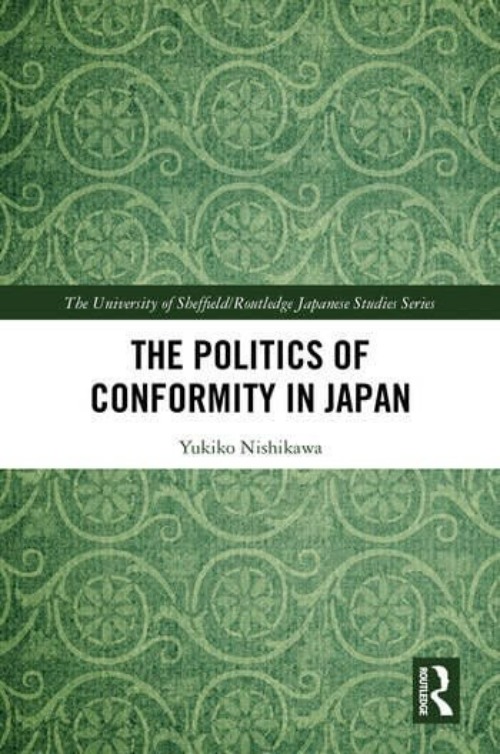
Title: The Politics of Conformity in Japan by Yukiko Nishikawa
Credit: Taylor & Francis
Usage Restrictions: Credit must be given to the creator. Only noncommercial uses of the work are permitted. No derivatives or adaptations of the work are permitted.
License: CC BY-NC-ND
| Contact |
|---|
Dr. Biplab Kumar Dash, Professor Yasuomi Urano, and their research team have uncovered a novel secretion mechanism of an unconventional Parkinson’s disease-related protein mediated by autophagy and secretory autolysosomes.
Proteins are conventionally trafficked and secreted extracellularly via the endoplasmic reticulum-Golgi pathway. Some proteins that bypass this system and use unconventional mechanisms to exit the cell have been implicated in neurodegenerative diseases, inflammation, and cancer. Researchers have elucidated a novel role of autophagy mediated by the formation of “secretory autolysosomes” in the release of PARK7—a protein associated with Parkinson’s disease (PD). Their findings uncover potential pathogenic mechanisms, early biomarkers, and therapeutic targets.
Reference
Biplab Kumar Dash, Yasuomi Urano, Yuichiro Mita, Yuki Ashida, Ryoma Hirose, Noriko Noguchi, Unconventional secretion of PARK7 requires lysosomal delivery via chaperone-mediated autophagy and specialized SNARE complex, Proceedings of the National Academy of Sciences, 2025, Vol. 122 No. 19
DOI :10.1073/pnas.2414790122
https://research.doshisha.ac.jp/news/news-detail-76/
https://www.doshisha.ac.jp/news/detail/001-26Qmmn.html
https://www.eurekalert.org/news-releases/1084893
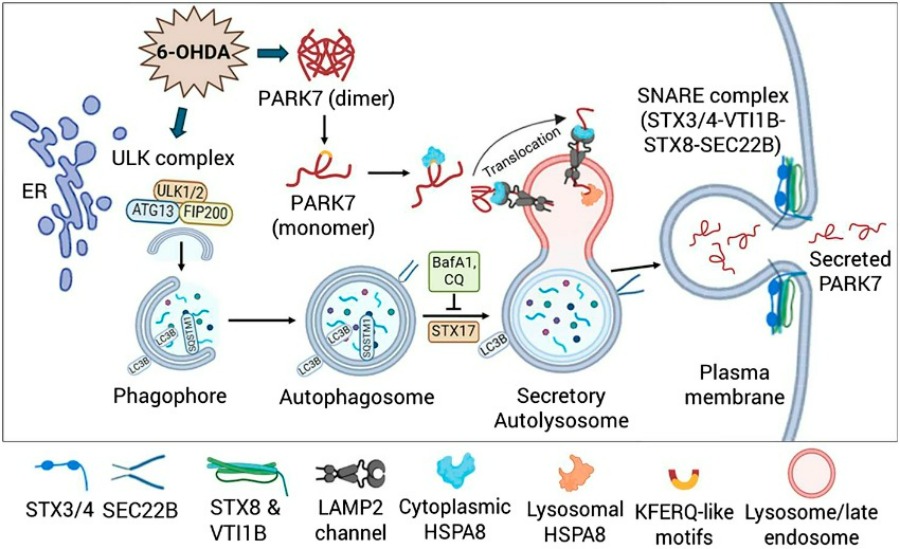
Image title: Proposed model of 6-OHDA-induced autophagy-based unconventional PARK7 secretion.
Image caption: Oxidative stress induced by 6-OHDA stimulates autophagy flux, which enhances STX17-mediated autolysosome formation, leading to the degradation of autophagosomal contents. However, in response to autophagy promotion by 6-OHDA, a subset of autophagosomes recruits ERGIC R-SNARE SEC22B. The KFERQ-like motifs of monomeric PARK7 selectively bind to HSPA8 chaperones and are recruited to the lysosomal membrane, followed by translocation into the lysosomal lumen via the LAMP2 channel. A pool of PARK7-containing lysosomes fuses with SEC22B-containing autophagosomes to form secretory autolysosomes, which then fuse with the plasma membrane mediated by a unique QabcR–SNARE complex comprising STX3/4, VTI1B, STX8, and SEC22B, releasing PARK7 into the extracellular matrix.
Image credit: Dr. Biplab Kumar Dash from Doshisha University, Japan
Source link: https://www.pnas.org/doi/10.1073/pnas.2414790122
License type: CC BY-NC-ND
Usage restrictions: Credit must be given to the creator. Only non-commercial uses of the work are permitted. No derivatives or adaptations of the work are permitted.
| Contact |
|---|
Professor Kojiro Ishii's research group investigated the relationship between phase angle, an indicator of muscle quality, and found it to be associated with memory performance and dementia risk in middle-aged and older adults.
Sarcopenia has been linked to dementia risk, but previous studies have focused on older adults. researchers assessed several muscle-related indices and cognitive function in middle-aged individuals. They found that phase angle—a measure of muscle quality—was strongly associated with cognitive function, especially in women. A significant association with memory performance was also observed in both genders. It could serve as an early marker for the risk of cognitive decline in clinical screenings.
Reference
Kentaro Ikeue, Hisashi Kato, Masashi Tanaka, Hajime Yamakage, Sayaka Kato, Masayo Iwasa, Kan Oishi, Yuiko Yamamoto, Megumi Kanasaki, Izuru Masuda, Kojiro Ishii, Noriko Satoh-Asahara, Phase Angle Is a Potential Novel Early Marker for Sarcopenia and Cognitive Impairment in the General Population, Journal of Cachexia, Sarcopenia and Muscle Volume16, Issue3, June 2025
DOI :10.1002/jcsm.13820
https://research.doshisha.ac.jp/news/news-detail-75/
This achievement has also been featured in the “EurekAlert!.”https://www.eurekalert.org/news-releases/1084858
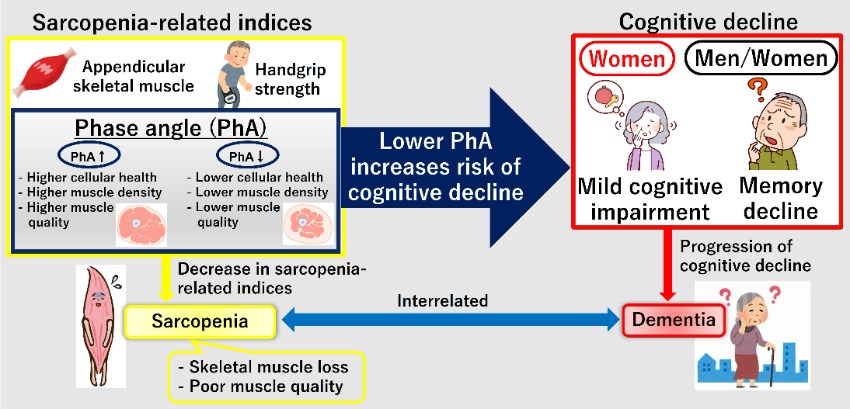
Image title: Overview of the study exploring the link between sarcopenia and cognitive decline
Image caption: This work investigated how various indicators of muscle quality, mass, and strength were related to cognitive parameters in middle-aged and older adults. The results showed that phase angle—an indicator of muscle quality that is very convenient to measure—was strongly related to cognitive decline.
Image credit: Postdoctoral Researcher Kentaro Ikeue from Doshisha University, Japan
License type: CC-BY 4.0
Usage restrictions: Credit must be given to the creator.
| Contact |
|---|
Professor Kiyotaka Nishikawa's research team has developed a tetravalent peptide that modulates a key bone resorption pathway, paving the way for effective treatments with fewer side effects.
Bone-destructive diseases often arise from overactive osteoclasts, driven by the RANK-TRAF6 signaling pathway. However, treatments targeting this pathway also affect other biological processes. Now, researchers have developed a new tetravalent peptide, CR4-WHD-tet, that fine-tunes this pathway. CR4-WHD-tet selectively inhibits signals important for late-stage osteoclast maturation without disrupting the pathway’s other essential functions. This innovative approach could lead to targeted therapies with reduced side effects for osteoporosis and similar diseases.
Reference
Masataka Anzai, Miho Watanabe-Takahashi, Hiroshi Kawabata, Yuri Masuda, Aoi Ikegami, Yuta Okuda, Tsuyoshi Waku, Hiroaki Sakurai, Keizo Nishikawa, Jun-ichiro Inoue, Kiyotaka Nishikawa, Clustered peptide regulating the multivalent interaction between RANK and TRAF6 inhibits osteoclastogenesis by fine-tuning signals, Communications Biology 8, Article number: 643 (2025)
DOI :10.1038/s42003-025-08047-2
For more details, please see the website of Organization for Research Initiatives and Development, Doshisha University.
https://research.doshisha.ac.jp/news/news-detail-74/
This achievement has also been featured in the “EurekAlert!.”
https://www.eurekalert.org/news-releases/1084690
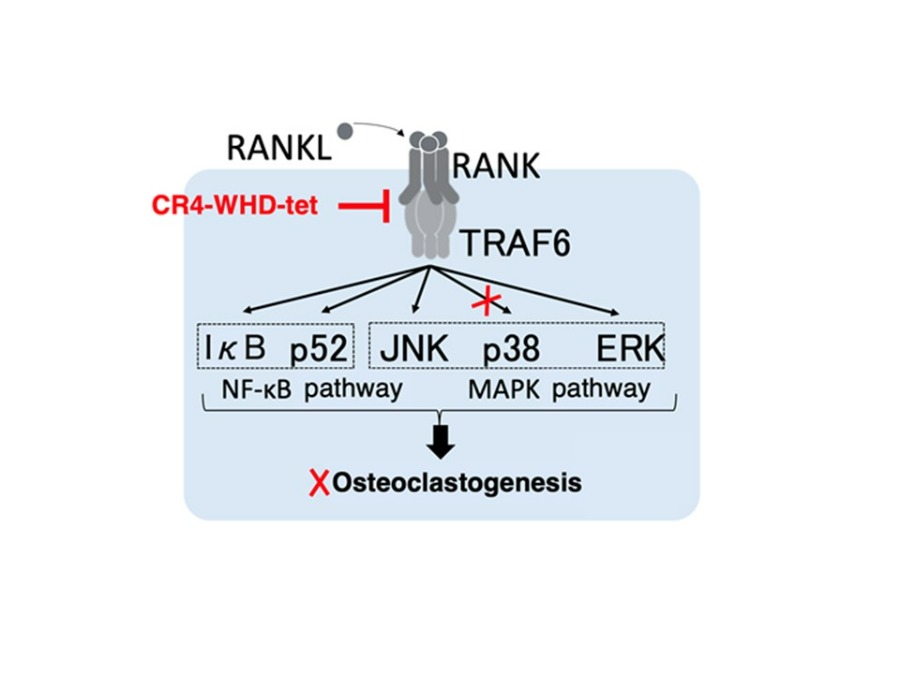
Image title: Inhibiting a specific downstream effect in the RANK-TRAF6 signaling pathway
Image caption: Rather than completely blocking all downstream signals, the peptide developed in this study focuses on inhibiting the activation of p38-MAPK. This is enough to downregulate the development of mature osteoclasts without affecting unrelated biological processes as a side effect.
Image credit: Professor Kiyotaka Nishikawa from Doshisha University, Japan
License type: Original content
Usage restrictions: Cannot be reused without permission.
| Contact |
|---|
On March 11 (Tuesday) and 12 (Wednesday), 2025, Doshisha University, in collaboration with the University of Tübingen, held the 5th International Interdisciplinary Symposium. The symposium took place at the Kambaikan Hardy Hall and the Ryoshinkan R305 at Doshisha University.
The theme of this symposium was “Humans and AI: Coexistence and Conscience – Toward a Future Where Humans and AI Develop Together for the Improvement of Society.” Researchers from various fields at Doshisha University and the University of Tübingen engaged in multi-perspective discussions.
During the keynote speech at Kambaikan Hardy Hall, President Katsuhiro Kohara of Doshisha University delivered a lecture titled “AI and Conscience: From the Perspective of Religious and Cultural Diversity.” During his lecture, President Katsuhiro Kohara emphasized the importance of constructing environmental ethics in light of the ongoing societal shift from natural and cultural environments to a digital one. He discussed how this transition calls for thoughtful consideration of environmental ethics in the midst of these changes. Professor Katja Schenke-Layland, Designated Vice President of the University of Tübingen, spoke about the Tübingen AI Center, a hub for AI in Europe, and the ELLIS-Institute Tübingen, a European network of excellence focusing on fundamental science, technological innovation, and societal impact. She highlighted how these initiatives are creating excellent research environments to attract top-level machine learning researchers from around the world.
In Panel 1, discussions were held on the transformative effects of large language models (LLMs) on communication and community-building, social robots and their role in communication, and the potential of AI’s massive visual data processing and modeling of neural processes. Ethical challenges in communication were also discussed.
On the following day, Panel 2 focused on the applications and developments of AI in space technology and medical sciences, while Panel 3 addressed legal issues surrounding regulation in marketing and organoid intelligence.
The symposium saw a total of 110 participants, including graduate students, engaging in lively discussions. New connections were formed in each of the thematic panels. The DU-UT Symposium is expected to contribute to the further development of research collaboration between both institutions.
Program
Keynote Lecture I
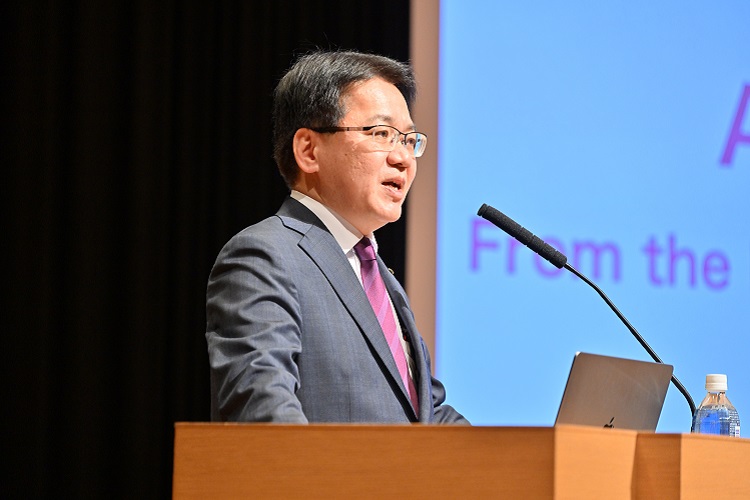
“AI and Conscience: From the Perspective of Religio-cultural Diversity”
Professor Katsuhiro KOHARA, Th.D., President, Doshisha University
Keynote Lecture II
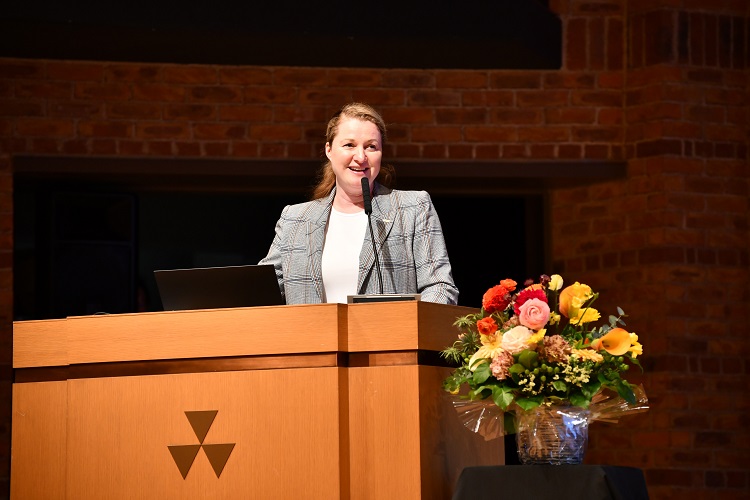
“Artificial Intelligence in Tübingen – Highlights and Perspectives”
Professor Dr. Katja SCHENKE-LAYLAND, Designated Vice President, University of Tübingen.
Discussion
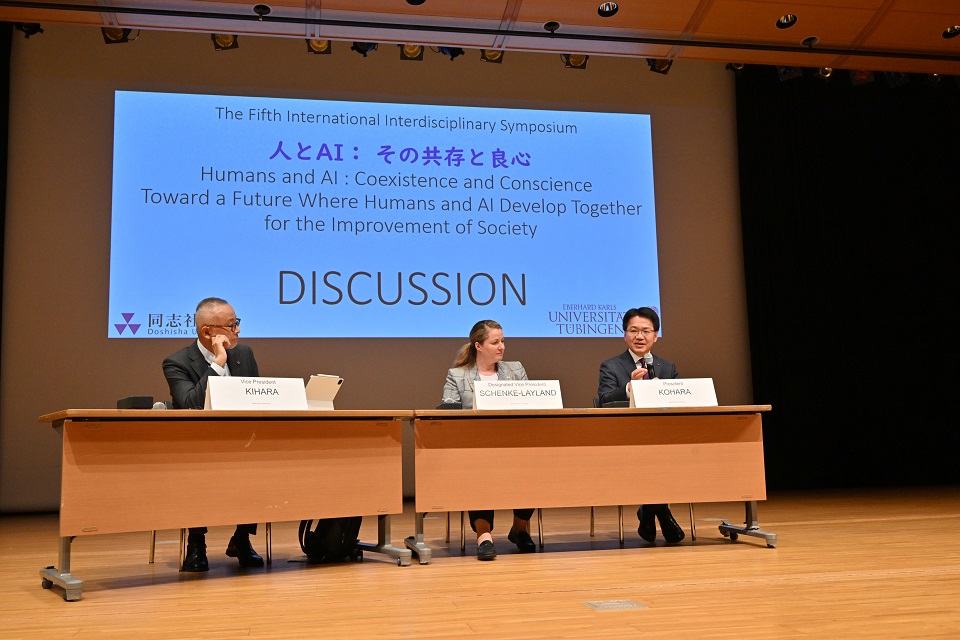
Professor Katsunobu KIHARA, Ph.D., Vice President, Doshisha University
Professor Dr. Katja SCHENKE-LAYLAND, Designated Vice President, University of Tübingen.
Professor Katsuhiro KOHARA, Th.D., President, Doshisha University
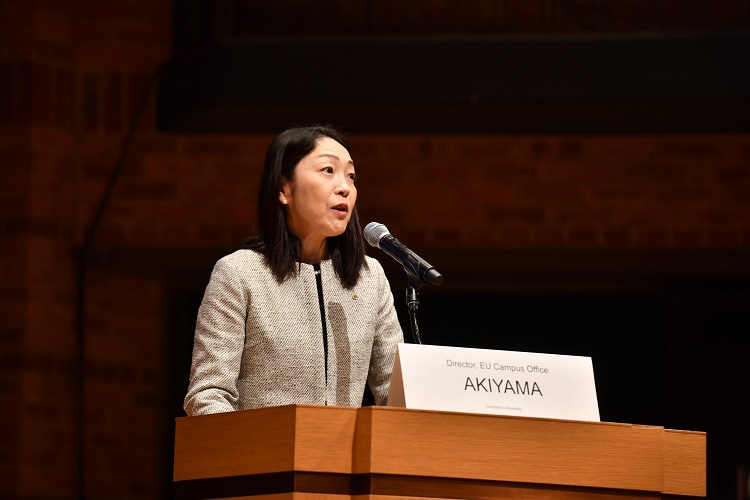
Professor Yoko AKIYAMA, Ph.D.
Director, Doshisha EU Campus at Tübingen University
Panel Ⅰ 【Humans and AI】
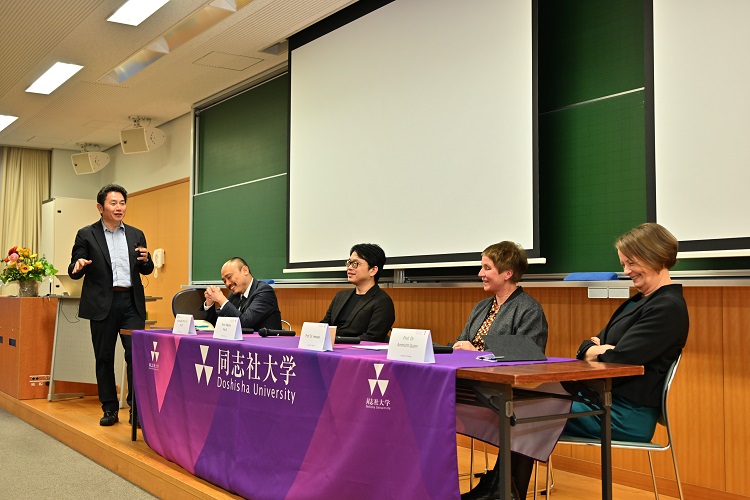
Professor Tomoyuki HIROYASU, Ph.D.
Associate Professor Takamasa IIO, Ph.D.
Professor Teppei MATSUI, Ph.D.
Professor Dr. Jessica HEESEN
Professor Dr. Regina AMMICHT QUINN
Panel II 【AI in Space Technology】
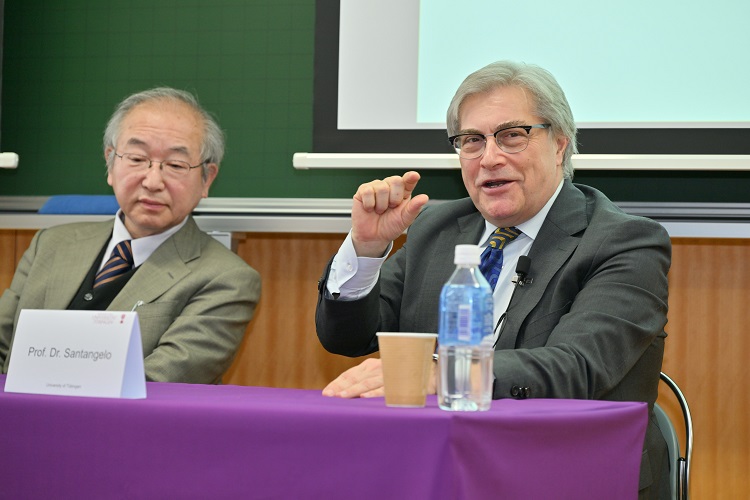
Visiting Professor Kazunari SHIBATA, Ph.D.
Professor Dr. Andrea SANTANGELO
Panel II 【AI in Medical Sciences】
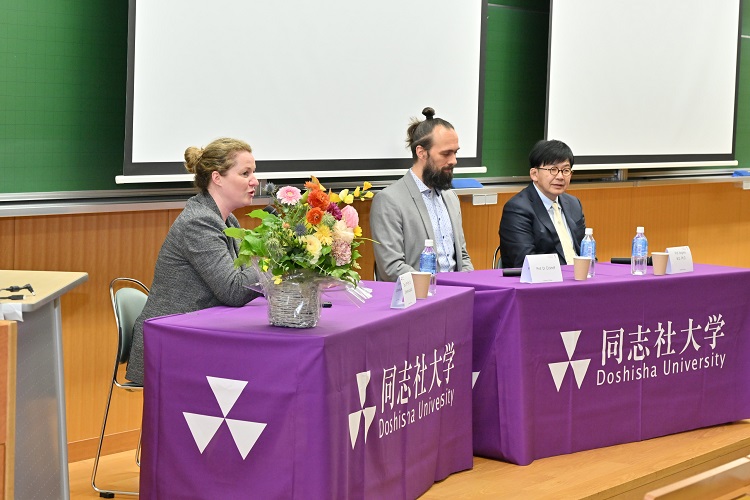
Professor Dr. Katja SCHENKE-LAYLAND
Professor Dr. Carsten EICKHOFF
Professor Masaya IKEGAWA, M.D., Ph.D.
Panel III 【AI and Legal Challenges】
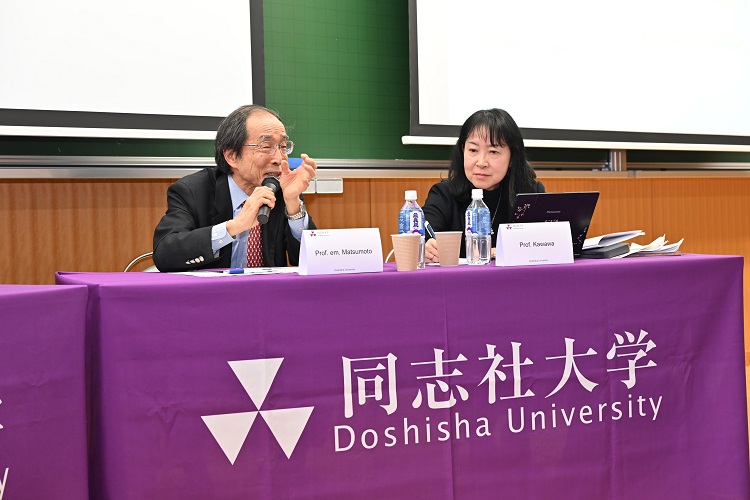
Professor Tsuneo MATSUMOTO
Professor Noriko KAWAWA
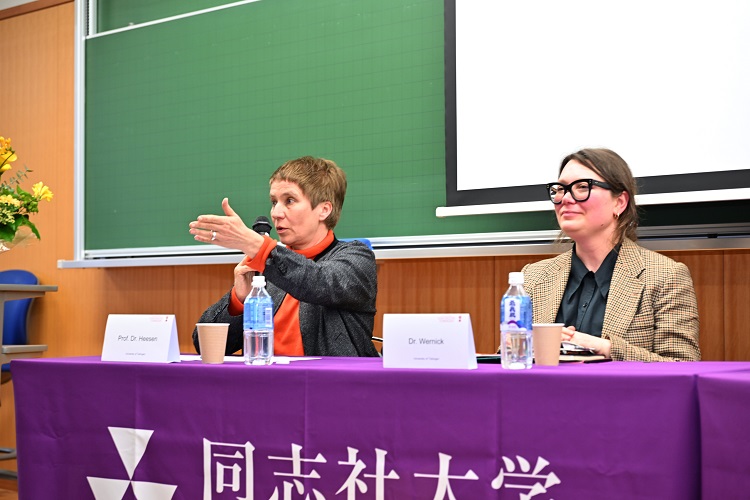
Professor Dr. Jessica HEESEN
Dr. Alina WERNICK
Group photo
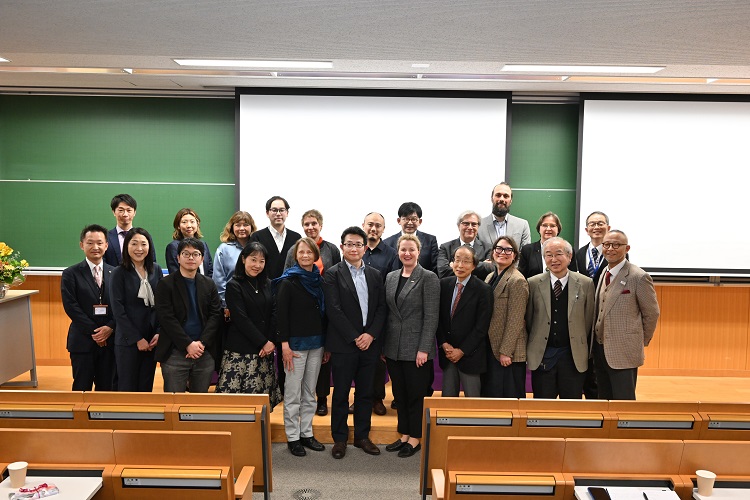
| Media contact |
Organization for Research Initiatives & Development Doshisha UniversityKyotanabe, Kyoto 610-0394, JAPAN |
|---|
Michael McGuire, at the Department of English, Faculty of Letters, and the colleague indicated that an automated speech recognition system shows promise for making language testing more accessible and scalable.
While elicited imitation (EI) tests can effectively measure language proficiency by having learners repeat complex sentences, they require time-consuming human scoring. McGuire and his colleague have developed a fully automated system that combines EI for speech recognition with a computational scoring metric. Their study showed that the automated system produced nearly identical overall scores to human raters, suggesting that this approach could enable efficient, large-scale language assessment and potentially transform educational practices.
Reference
Michael McGuire, Jenifer Larson-Hall, Assessing Whisper automatic speech recognition and WER scoring for elicited imitation: Steps toward automation, Research Methods in Applied Linguistics, Volume 4, Issue 1, 2025,100197, ISSN 2772-7661,
https://doi.org/10.1016/j.rmal.2025.100197
https://research.doshisha.ac.jp/news/news-detail-73/
This achievement has also been featured in the “EurekAlert!.”
https://www.eurekalert.org/news-releases/1080114
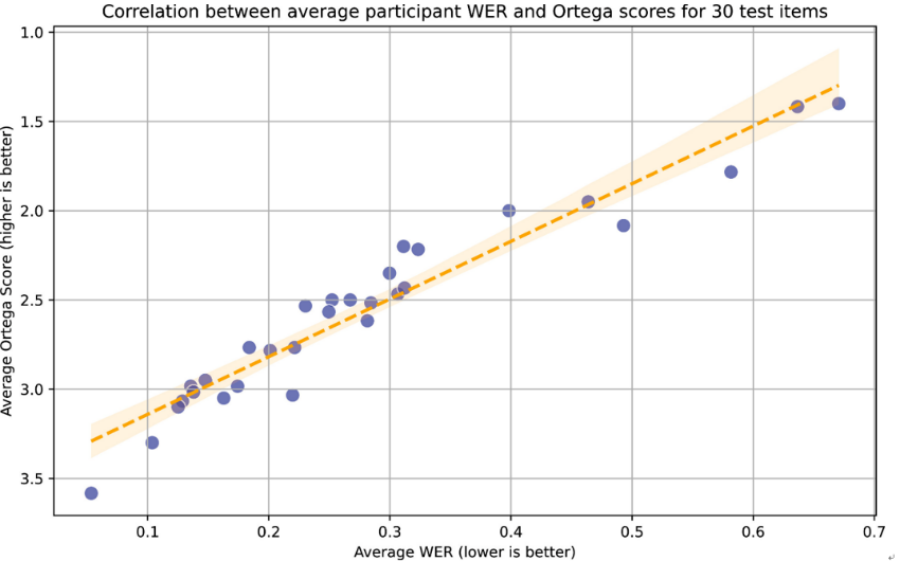
Title: Comparison between the proposed computer-automated assessment method and the established manual scoring method
Caption: The good linearity depicted in this plot indicates excellent agreement between manual scoring and fully automated scoring, showcasing the potential of the proposed system.
Credit: Michael McGuire from Doshisha University, Japan
Image license: CC BY 4.0
Usage restrictions: You are free to share and adapt. Attribution is required.
| Contact |
|---|
The research team, including Shumpei Hara, Associate Professor at the Faculty of Science and Engineering, Doshisha University discover a unique “meandering motion” in viscoelastic fluids, opening possibilities for energy-efficient heat exchangers and cooling systems.
In a step towards advancing fluid dynamics for industrial applications, researchers unveil a meandering motion of turbulence observed in viscoelastic fluids flowing over a backward-facing step. According to the study, under certain conditions, these fluids exhibit wavelike movement, which enhances heat transfer efficiency. This breakthrough holds promise for industrial applications of fluid-based thermal management, providing energy-efficient systems.
Reference
Shumpei Hara, Ryusuke Ii, Shohei Onishi, Takahiro Tsukahara, Yasuo Kawaguchi, Inertia-viscoelastic meandering motion in a backward-facing step flow, International Journal of Heat and Mass Transfer 242 126793-126793 June 2025
DOI : 10.1016/j.ijheatmasstransfer.2025.126793
For more details, please see the website of Organization for Research Initiatives and Development, Doshisha University.
https://research.doshisha.ac.jp/news/news-detail-71/
This achievement has also been featured in the “EurekAlert!.”
https://www.eurekalert.org/news-releases/1079126
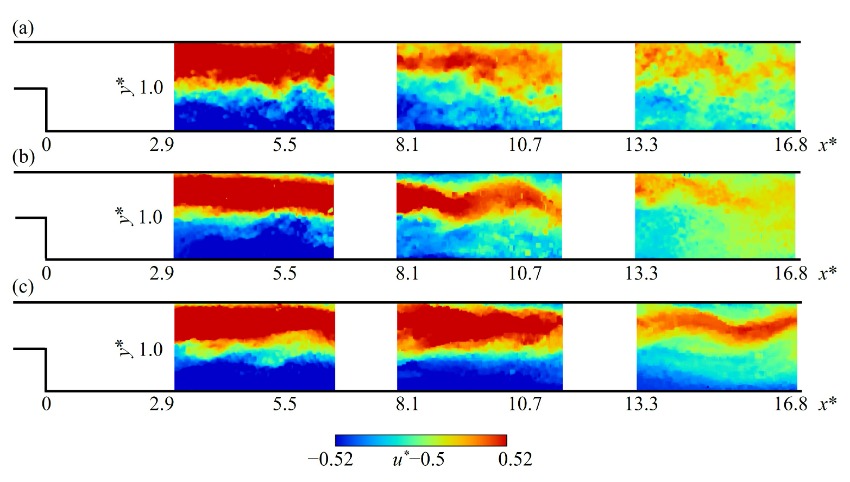
Image title: Instantaneous streamwise velocity fields with Galilean transformation by the half bulk velocity in the x-y plane
Image caption: Visualization of instantaneous streamwise velocity fields in the x-y plane for different Weissenberg numbers (Wi = 0.0, 0.019, 0.022). The meandering motion emerges at higher Wi, enhancing turbulence and heat transfer in the backward-facing step flow.
Image credit: Dr. Shumpei Hara from Doshisha University, Japan
Image link: https://www.sciencedirect.com/science/article/pii/S0017931025001346?via%3Dihub
License type: CC BY 4.0
Usage restrictions: You are free to share and adapt. Attribution is required.
| Contact |
|---|
Dr. Hirotsugu Azechi and Dr. Susumu Takahashi, Graduate School of Brain Sciences, develop Virtual Marker Tracking (vmTracking) to study the movement patterns of multiple animals in crowded spaces.
Understanding the movement patterns of animals is crucial for analyzing complex behaviors. However, accurately tracking the poses of individuals in crowded and densely populated environments remains a major challenge. Azechi and Takahashi have developed ‘Virtual Marker Tracking’ (vmTracking), which assigns virtual markers to animals, enabling consistent identification and posture tracking even in crowded environments. Their findings offer a simple, effective solution for tracking multiple animals in complex spaces for precise behavioral studies.
Reference
Azechi H, Takahashi S (2025) vmTracking enables highly accurate multi-animal pose tracking in crowded environments. PLoS Biol 23(2): e3003002.
https://doi.org/10.1371/journal.pbio.3003002
https://research.doshisha.ac.jp/news/news-detail-70/
This achievement has also been featured in the “EurekAlert!.”https://www.eurekalert.org/news-releases/1074166

Title: vmTracking enables accurate identification in crowded environments
Caption: Conventional markerless tracking methods struggle with body part misestimations or missing estimates in crowded spaces. In vmTracking, markerless multi-animal tracking is performed on a video containing multiple individuals. The resulting tracking output may not always be fully accurate. However, since some of these markers are extracted and used as virtual markers for individual identification, high overall accuracy at this stage is not required. By applying single-animal DeepLabCut to the generated virtual marker video, more accurate pose-tracking results can be obtained compared to conventional methods.
Credit: Hirotsugu Azechi from Doshisha University, Japan
Image license: Original content
Usage restrictions: Cannot be used without permission
| Contact |
|---|
The research team, including Yasuomi URANO and Noriko NOGUCHI, professors at the F Graduate School of Life and Medical Sciences reveal that 25-hydroxycholesterol induces a particular type of cell death called ferroptosis, which could be implicated in several degenerative diseases.
Oxysterols, molecules derived from cholesterol, play crucial roles in our bodies but can also contribute to various diseases. Now, researchers from Japan have discovered that 25-hydroxycholesterol (25-OHC) triggers a specific type of cell death called ferroptosis in nerve-supporting cells. The study reveals that 25-OHC disrupts cellular protective mechanisms and antioxidant systems. These findings could lead to new diagnostics and treatments for conditions, like amyotrophic lateral sclerosis, where elevated 25-OHC levels have been observed.
Reference
Yasuomi Urano, Anan Iwagaki, Arisa Takeishi, Nazuna Uchiyama, Noriko Noguchi, Downregulation of the SREBP pathways and disruption of redox status by 25-hydroxycholesterol predispose cells to ferroptosis. Free Radical Biology and Medicine, Vol. 228, pp 319-328, 16 February 2025,
DOI:https://doi.org/10.1016/j.freeradbiomed.2025.01.010
For more details, please see the website of Organization for Research Initiatives and Development, Doshisha University.
https://research.doshisha.ac.jp/news/news-detail-69/
This achievement has also been featured in the “EurekAlert!.”
https://www.eurekalert.org/news-releases/1074198/
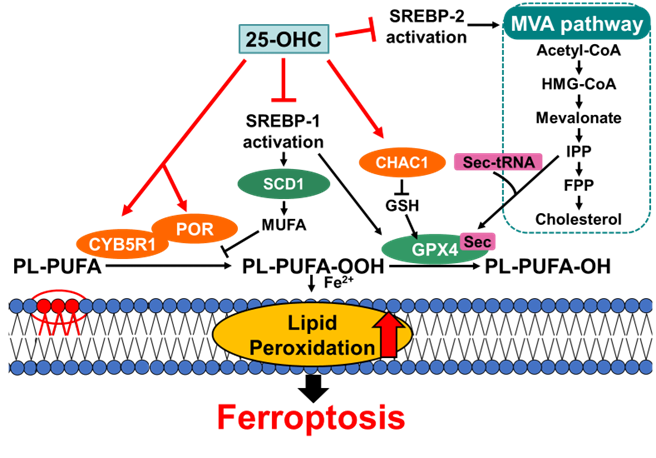
Image title: Overview of the proposed mechanism of 25-OHC-induced ferroptosis
Image caption: This image summarizes the main findings of the study, showing the multifaceted effects that exposure to 25-hydroxycholesterol (25-OHC) has on Schwann cells.
Image credit: Professor Yasuomi Urano from Doshisha University, Japan
License type: CC BY 4.0
Image source link:
https://www.sciencedirect.com/science/article/pii/S0891584925000103?via%3Dihub
Usage restrictions: You are free to share and adapt but credit must be given to the creator.
| Contact |
|---|
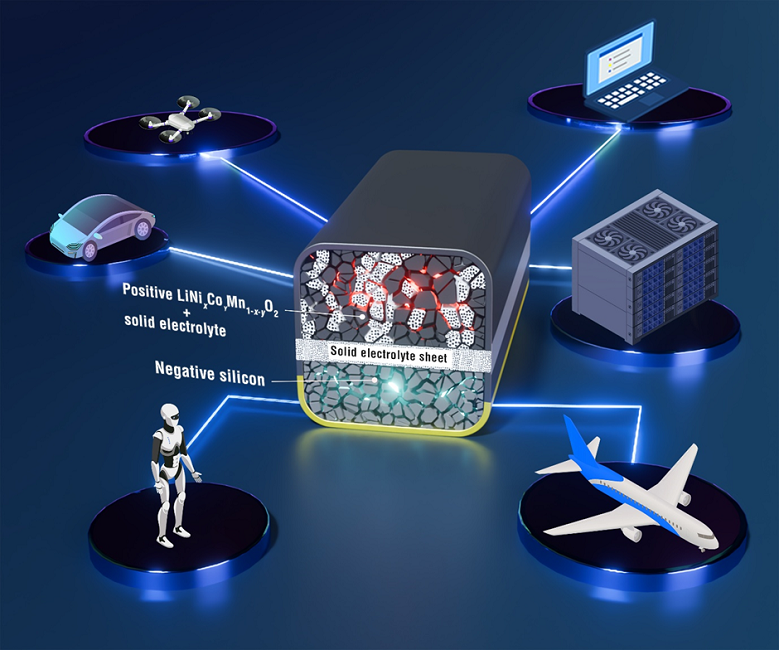 New quasi-solid-state lithium-ion-battery can revolutionize the widespread application of electric vehicles and devices
New quasi-solid-state lithium-ion-battery can revolutionize the widespread application of electric vehicles and devicesResearchers from Doshisha University, Japan, develop a novel quasi-solid-state lithium-ion battery (LIB) with non-flammable solid and liquid electrolytes. The battery has higher ionic conductivity, improved cycle performance, and better safety than conventional LIBs.※
.
The research team, including Mr. Ryosuke Kido,a second-year doctoral fellow and Takayuki Doi, professor at the Faculty of Science and Engineering Department of Molecular Chemistry and Biochemistry develop a quasi-solid-state lithium-ion battery with improved stability, safety, and longevity.
Electric devices and vehicles offer a sustainable and economical alternative to fuel-driven machines. However, concerns about the safety and longevity of conventional lithium ion batteries (LIBs) persist. A study from Doshisha University aimed to develop a novel flame-retardant quasi-solid-state battery by combining solid and liquid electrolytes. With higher safety and durability and improved performance, the new LIB has the potential to transform the applications of electric vehicles and devices.
Reference
Ryosuke Kido, Taisuke Horikawa, Atsushi Sano, Tsuyoshi Nagashima, Ryo Okada, Minoru Inaba, Takayuki Doi, Highly safe quasi-solid-state lithium ion batteries with two kinds of nearly saturated and non-flammable electrolyte solutions. Journal of Energy Storage, 102, 114115, 2024,
DOI: 10.1016/j.est.2024.114115
For more details, please see the website of Organization for Research Initiatives and Development, Doshisha University.
Safe and Energy-Efficient Quasi-Solid Battery for Electric Vehicles and Devices
This achievement has also been featured in the “EurekAlert!.”NEWS RELEASE 13-JAN-2025,
[Research News] Safe and Energy-Efficient Quasi-Solid Battery for Electric Vehicles and Devices
※
Credit: Ryosuke Kido from Doshisha University
License type:Original content
Usage restriction:Credit must be given to the creator.
| Contact |
|
|---|
 Understanding the influence of cultural identity in intercultural communication.
Understanding the influence of cultural identity in intercultural communication.Culture may or may not be a relevant factor in intercultural communications for people globally. In this study, Professor Stadler from Doshisha University examines the relevance of intercultural communications.※
.
Professor Stefanie Alexa Stadler, Faculty of Letters Department of English, discusses how cultural differences can affect the dynamics of informal communications in a new linguistic report.
Intercultural communication is vital in today’s growing and connected world. However, differences in cultural and linguistic practices often result in miscommunication. Emphasizing the relevance of culture in informal communication, Professor Stadler explores how cultural differences can affect interaction patterns. The study discusses diverse interactions from East and Southeast Asian settings to reveal how culture often becomes the focal point in conversation, which plays a vital role in international communication.
Reference
Stadler, S. (2024). When culture becomes relevant in intercultural lingua franca communication.World Englishes, 1–19.
https://doi.org/10.1111/weng.12720
For more details, please see the website of Organization for Research Initiatives and Development, Doshisha University.
Connecting Through Culture: Understanding Its Relevance in Intercultural Lingua Franca Communication
This achievement has also been featured in the “EurekAlert!.”NEWS RELEASE 10-JAN-2025,
[Research News] Connecting Through Culture: Understanding Its Relevance in Intercultural Lingua Franca Communication
※
Credit: Multicultural Globe by Jimee, Jackie, Tom & Asha
License type:CC BY SA 2.0
Usage restriction:Credit must be given to the creator. Adaptations must be shared under the same terms.
https://openverse.org/en-za/image/25818e89-4915-48ef-9ade-7c6ad561050c
| Contact |
|
|---|
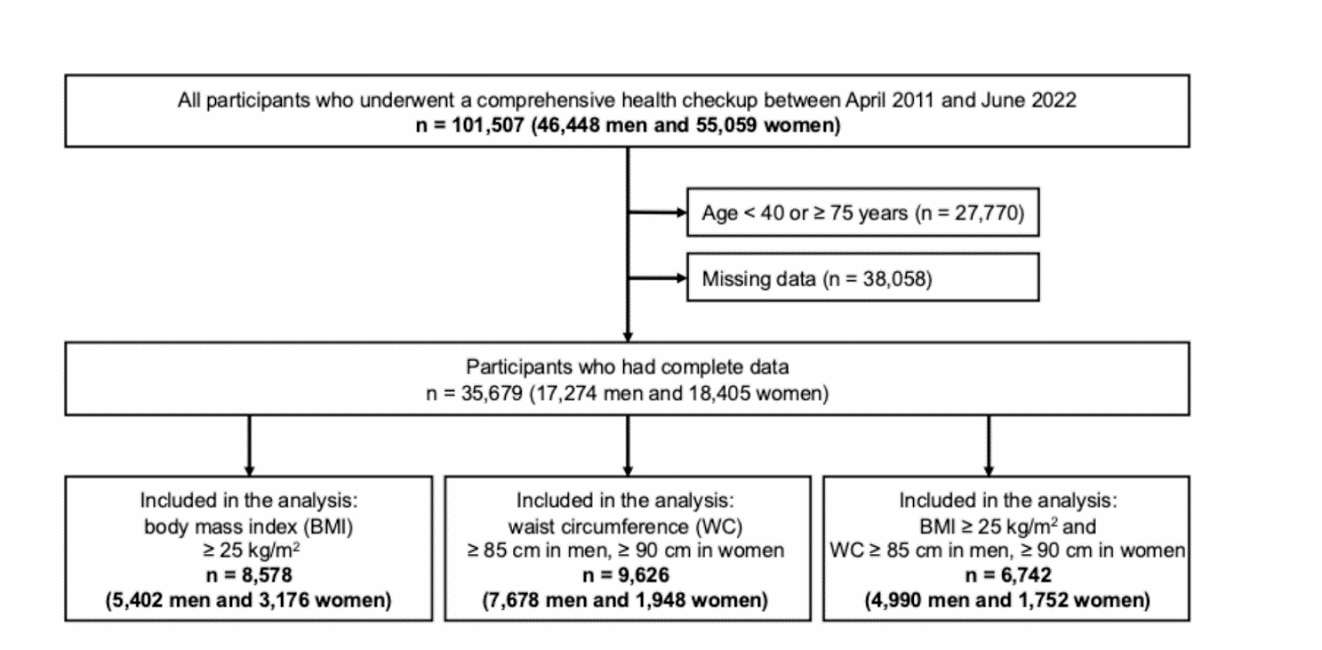 A Flowchart illustrating the study participants, including exclusions based on age and missing data, and categorization by obesity criteria (BMI and waist circumference).
A Flowchart illustrating the study participants, including exclusions based on age and missing data, and categorization by obesity criteria (BMI and waist circumference).Researchers from Doshisha University used walking speed assessments to reveal that individuals with obesity who perceived their subjective walking speed as fast had a lower likelihood of metabolic diseases. This study highlights the potential for earlier intervention in preventing the cascade of diseases associated with obesity.※
.
Professor Kojiro Ishii, Faculty of Health and Sports Science, and his team reveal subjective walking speed as a quick, equipment-free tool for identifying metabolic health risks.
Ishii’s team has found that subjective walking speed, assessed by asking individuals to compare their pace with peers, is linked to lower odds of metabolic diseases like diabetes, hypertension, and dyslipidemia in individuals with obesity. This simple, equipment-free assessment could serve as an effective tool in health examinations, paving the way for earlier interventions to prevent the “metabolic domino effect” triggered by obesity-related disorders.
Reference
Yuiko Yamamoto, Kentaro Ikeue, Megumi Kanasaki, Hajime Yamakage, Kan Oishi, Takaaki Mori, Noriko Satoh-Asahara, Izuru Masuda & Kojiro Ishii. Association between subjective walking speed and metabolic diseases in individuals with obesity: a cross-sectional analysis. Sci Rep 14, 28228 (2024).
https://doi.org/10.1038/s41598-024-78541-w
For more details, please see the website of Organization for Research Initiatives and Development, Doshisha University.
Walking Speed as a Simple Predictor of Metabolic Health in Obese Individuals.
This achievement has also been featured in the “EurekAlert!.”NEWS RELEASE 19-DEC-2024,
[Research News] Walking Speed as a Simple Predictor of Metabolic Health in Obese Individuals
※
Credit: Kojiro Ishii from Doshisha University, Japan
License type:CC BY-NC-ND 4.0
Usage restriction:Credit must be given to the creator. Only noncommercial uses of the work are permitted. No derivatives or adaptations of the work are permitted.
| Contact |
|
|---|